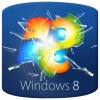Intel and its partners are about to launch biggest promotion yet for the Ultrabook – an ultra-thin notebook spec designed to compete with the MacBook Air. Windows is preparing to launch its latest, and they claim, greatest version of Windows named Windows 8. These two products are the ammunition that combines to make up the “secret weapon” they hope will wipe out the gains Apple has made in the marketplace.
 Tim Bajarin for Time Techland:
Tim Bajarin for Time Techland:
In the case of Ultrabooks, I actually see them as the natural evolution of laptops and not revolutionary as Intel would like us to think. Rather, they take advantage of the industry’s constant push to make things smaller, lighter, thinner and with better battery life. For mainstream users who have had to lug around their rather bulky laptops for the last five years, they would be justified in asking Intel and the PC vendors “What took you so long?” given that Apple has had their MacBook Air on the market for five years and defined what an Ultrabook should be.
And with Windows 8 and Metro, Microsoft is also following an evolutionary path towards touch UI’s with its Metro based smart phones and soon to be Metro based tablets and PC’s. Again, consumers could ask Microsoft “What took you so long?” since Apple has had their touch UI on the iPhone for five years and on their iPads for two years.
Bajarin believes both products may be missing the targets they’re designed to hit. Ultrabooks are most likely to have a starting price of between $799-$899, which he says completely misses the mainstream laptop market that sees the bulk of laptops sold at prices between $299-$599.
Windows 8 and Metro face the challenge that while Metro is great on phones and tablets, it doesn’t translate well to the touchscreen-less laptop PCs. He says that using the consumer preview of Windows 8 and the Metro interface can prove frustrating when used with a trackpad.
Bajarin continues: “The secret weapon is a new form factor often referred to as “hybrids.” These are tablets that can be docked into a keyboard, effectively making them either a laptop or a laptop with a detachable keyboard. You might think those two are one in the same, but they’re actually very different in terms of design goals. In the former’s case, the design is specifically around the tablet, and the keyboard dock is modular. We already have a lot of examples of this with the iPad where the tablet is the central device and the attachable Bluetooth keyboards are more of an afterthought. In this case, the keyboard just supports the input functions of the tablet.
“But in the latter case, the design resembles more a slim laptop or Ultrabook-like casing, and the screen can be taken off and used as a tablet. I believe this latter design is the secret weapon that Microsoft and Intel can use against Apple and at least on paper, give Apple a run for its money, especially in business and enterprise. And to a lesser extent, it could be hot in some consumer segments where the keyboard is critical and users want a laptop-centered experience as well.”
One possibility that could derail Intel and Microsoft’s “hybrid” strategy is if Apple creates a hybrid design that combines the iPad and the MacBook Air. Using a version of an iOS/OS X hybrid operating system, the device could act as a “normal” laptop in one configuration, and an iPad like device in the other.
This is what makes a job like this fun, bring able to sit in the front row and watch what happens as the giants fight it out amongst themselves. Who will be the champ? I don’t think you even have to try hard to guess who my money is on…


